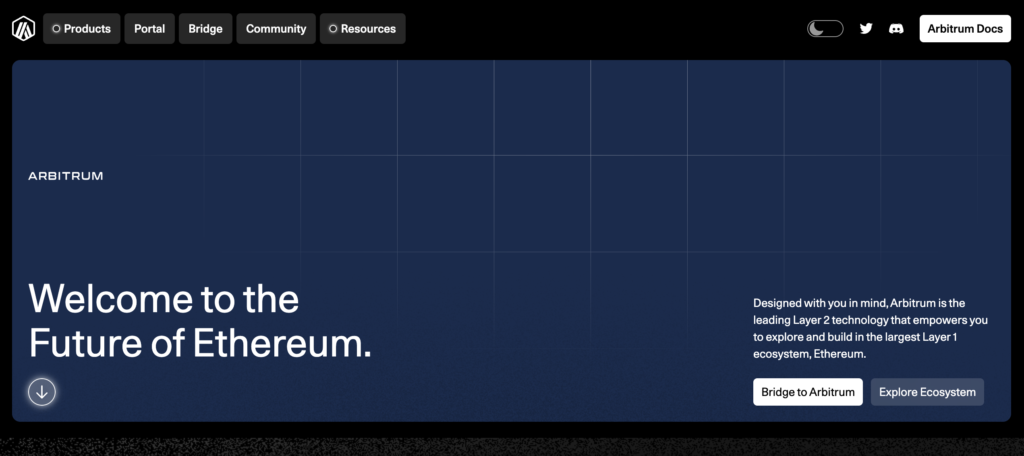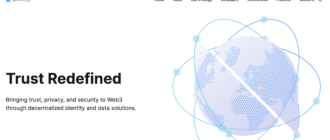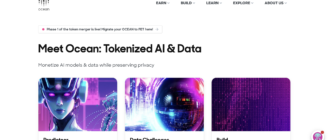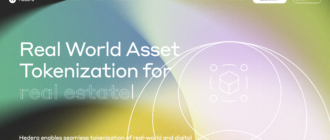Arbitrum is a Layer 2 scaling solution for Ethereum that aims to improve the scalability and efficiency of Ethereum-based applications while maintaining security and decentralization. It uses a unique technology approach to offload the computational and storage burden from the main Ethereum chain onto a compatible, faster, and cheaper layer.

Project History
The origins of Arbitrum trace back to research at Princeton University. Developed by Offchain Labs, its founding team includes notable academics and experts in the field of computer science. The project gained significant attention as Ethereum faced increasing congestion and high gas fees. Noteworthy milestones include the public testnet launch, followed by the mainnet launch, and partnerships with major decentralized applications (dApps) to enhance Ethereum’s scalability solutions.
What is Arbitrum
Arbitrum is not just a single blockchain but a network of chains offering a Layer 2 solution leveraging Optimistic Rollups. This technology aims to reduce fees and increase transaction throughput for decentralized applications without sacrificing the security guarantees provided by the main Ethereum blockchain. It addresses the limitations of Ethereum’s scalability by processing transactions off-chain and settling finality on the Ethereum mainnet.
How Arbitrum Works?
Arbitrum is built on a sophisticated technological framework known as Optimistic Rollups. This technology is pivotal for enhancing transaction throughput and reducing transaction costs on the Ethereum blockchain by handling the execution of smart contracts off-chain.
Blockchain Technology
Unlike typical blockchains, Arbitrum doesn’t operate its own blockchain in the traditional sense. Instead, it runs a Layer 2 protocol on top of Ethereum, which consists of a network of off-chain nodes. These nodes execute transactions and maintain the state off-chain, but unlike sidechains, Arbitrum derives its security directly from Ethereum. The connection between Arbitrum and Ethereum ensures that while Arbitrum can operate at higher efficiency, it still benefits from the robust security mechanisms of the Ethereum mainnet.
Consensus Mechanism
Arbitrum uses a unique consensus mechanism that is quite different from mainstream Proof of Work or Proof of Stake models. The core principle behind Arbitrum’s consensus approach is based on Optimistic Rollup technology. In this model, transactions are batched together and executed off-chain, and only the data of these transactions is posted to the Ethereum network. The system operates on a “trust, but verify” model where it is assumed that all transactions are valid unless proven otherwise. Validators, who are incentivized to act honestly through economic penalties in case of fraud, can challenge the transaction results within a disputable period, usually one week.
This “optimistic” approach means that while it’s presumed that actions are correct, there is a mechanism in place to challenge and correct if something goes wrong, which significantly reduces the data and computation load on the main Ethereum chain.
Distinctive Features Compared to Other Projects
One of the distinguishing features of Arbitrum compared to other scaling solutions is its AnyTrust guarantee. This means that for the system to remain secure and honest, only one honest validator is necessary, compared to other systems which might require a majority or supermajority of honest validators. This significantly reduces the barrier to ensuring network security and integrity.
Additionally, Arbitrum stands out for its ability to execute general Ethereum transactions, not just simple token transfers, at scale. This includes complex smart contracts that can be directly ported from Ethereum without modification. Arbitrum’s compatibility with Ethereum’s tooling and contracts, such as using the same Solidity smart contracts, provides a seamless experience for developers, which many alternative Layer 2 solutions do not offer.
Technical Details and Their Implications
Arbitrum enhances transaction speeds and lowers costs through efficient batch processing of off-chain transactions before final settlement on Ethereum. By minimizing the data sent to Ethereum and compressing it, Arbitrum reduces the required block space on Ethereum, thereby lowering the transaction fees.
In summary, Arbitrum’s use of Optimistic Rollups, unique consensus mechanism, and AnyTrust guarantees provide a secure, scalable, and developer-friendly environment. Its deep integration with Ethereum’s security model and minimal changes required for existing Ethereum applications make it an innovative and powerful solution for scaling Ethereum applications.
What are Optimistic Rollups?
Optimistic Rollups are a Layer 2 scaling solution designed to increase the transaction throughput and reduce costs on blockchain platforms like Ethereum. They play a crucial role in expanding the capabilities of blockchains without compromising the security and decentralization inherent to the main chain.
Core Principles of Optimistic Rollups
Optimistic Rollups operate on the assumption that all transactions and state transitions processed on their layer are correct by default. This assumption allows them to handle transactions outside the main blockchain (off-chain), thereby relieving the network of the computational burden that comes with verifying every transaction.
How Optimistic Rollups Work
- Transaction Batching: Transactions are executed and state transitions are handled in an off-chain environment. These are then batched together into a single “rollup block.”
- Data Posting: Only essential data related to these transactions is posted back to the main blockchain. This includes roots of the state and the outcome of transactions but not the entire data set of the transactions, making it much lighter and cheaper to store.
- Dispute Resolution: Since transactions are assumed to be valid, the system only performs computation on the main chain if a transaction is disputed. Validators or watchers on the network can challenge a transaction within a fixed ‘challenge window’ by providing proof of its invalidity. If a transaction is challenged, the Optimistic Rollup must perform a computation to verify the claim directly on the main blockchain.
- Finality and Security: Once the challenge window closes without disputes, or after a dispute is resolved, the transactions are considered final. This delayed finality is a trade-off for enhanced throughput and lower costs.
Advantages of Optimistic Rollups
- Scalability: By offloading the computation and storage from the main blockchain, Optimistic Rollups significantly increase transaction throughput.
- Cost Efficiency: Less data on the blockchain means lower transaction fees, as the costly process of on-chain computation and data storage is minimized.
- Security: Despite operating off-chain, the security model leverages the underlying blockchain’s security, ensuring that only valid state transitions are finalized.
- Developer Friendliness: They allow developers to deploy existing smart contracts with little or no modification, which is highly beneficial for projects looking to scale without redesigning their applications.
Limitations
- Latency: The challenge period introduces latency in transaction finality, which might not be suitable for applications requiring immediate finality.
- Capital Efficiency: The system requires participants to lock up funds for challenging fraudulent transactions, which might not be capital efficient.
Optimistic Rollups represent a significant technological approach in the field of blockchain scalability solutions. By balancing between efficiency, security, and ease of use, they offer a promising avenue for expanding the capability of existing blockchain infrastructures.
Tokenomics of Arbitrum: The ARB Token
Nature of ARB: Token or Coin?
ARB is a token, not a coin, functioning within the Arbitrum ecosystem. As a token, ARB is not used as direct currency but serves specific purposes such as governance, which involves voting rights on protocol decisions, and potentially other utility functions within the ecosystem.
Tokenomics of ARB
The ARB token is primarily used as a governance token, allowing holders to participate in the decision-making process for changes and upgrades to the Arbitrum network. This involvement is crucial for maintaining a decentralized and user-driven approach to network updates and policy changes.
Emission Model
ARB was introduced through a controlled emission model. The total supply of ARB tokens is fixed, ensuring that inflation does not devalue holder investments over time. A certain percentage of the tokens were distributed to early users and developers, incentivizing participation and development within the Arbitrum ecosystem. The rest are allocated for future distribution to support network growth, community initiatives, and partnership incentives.
Current Market Dynamics
The market value of ARB is subject to changes based on demand and supply dynamics within the market. As a governance token with a fixed supply, its value can be influenced by factors such as the increasing adoption of the Arbitrum network, the number of dApps choosing to build on it, and the general market conditions in the cryptocurrency space.
Storage and Usage
Holders of ARB tokens typically store their tokens in Ethereum-compatible wallets, given that Arbitrum operates as a Layer 2 solution over Ethereum. This compatibility with Ethereum’s infrastructure simplifies interactions and broadens the accessibility for users to manage and utilize their ARB tokens, whether for governance, staking in future scenarios, or as part of liquidity provisioning in decentralized finance (DeFi) applications.
Long-term Value Proposition
The value proposition of the ARB token hinges on its utility within the Arbitrum ecosystem. As the platform continues to scale and attract more projects, the importance and utility of ARB are likely to increase, potentially enhancing its value as a pivotal component of the governance framework. This aspect makes ARB an attractive asset for those looking to influence the development trajectory of a major Ethereum scaling solution.
In summary, the introduction of the ARB token adds a new layer to Arbitrum’s ecosystem, directly engaging its community in governance while potentially adding various utility functions that could expand its role in the network’s operations and security.
Where to Buy the ARB Token?
For those interested in purchasing the ARB token, several major cryptocurrency exchanges offer it. These platforms provide reliable and secure trading options:
- Binance: Known for its high liquidity and broad user base, Binance is a popular choice for trading ARB. It supports multiple trading pairs with ARB, allowing users flexibility in their trading strategies.
- HTX (formerly Huobi): This exchange provides a robust platform with a strong emphasis on security and customer service, making it a viable option for acquiring ARB tokens.
- MEXC: Known for listing a wide variety of tokens quickly after their launch, MEXC is a good choice for those looking to trade ARB, particularly in markets not always available on other platforms.
- Bybit: Bybit offers a user-friendly interface and strong trading features, making it suitable for both new and experienced traders looking to acquire ARB tokens.
- KuCoin: This exchange is favored for its wide selection of cryptocurrencies and its user-friendly platform, which is ideal for those looking to diversify their holdings with ARB.
- Bitfinex: Offers sophisticated trading features that cater to advanced traders looking to trade ARB, with strong liquidity and multiple fiat and cryptocurrency pairs.
Where to Store the ARB Token?
When it comes to storing ARB tokens, security and accessibility are paramount. Here are some recommended wallets:
Hardware Wallets
- Ledger Wallets: These provide top-notch security by storing tokens offline. Ledger wallets support Ethereum and ERC-20 tokens like ARB, making them a secure choice for long-term storage.
- Trezor Wallets: Similar to Ledger, Trezor offers offline storage, effectively protecting the tokens from online threats. They are easy to use and compatible with ERC-20 tokens.
Software Wallets
- MetaMask: As an Ethereum-based token, ARB can be easily managed through MetaMask. This wallet is widely used for interacting with decentralized applications directly from the browser.
- Trust Wallet: Offers a mobile-first experience, supporting a wide range of cryptocurrencies including ERC-20 tokens like ARB. Trust Wallet provides a balance of security and convenience for daily use.
Considerations for Storage
Choosing between a hardware and a software wallet depends on your needs for security versus convenience. Hardware wallets are best for those holding significant amounts of ARB as an investment, due to their robust security features. Software wallets, while still secure, offer more convenience and faster access to funds, making them suitable for active traders and those frequently interacting with dApps. For governance activities, keeping your tokens in a software wallet like MetaMask can facilitate participation in voting and other governance actions directly linked to the Arbitrum ecosystem.
Future Prospects and Development Forecast
Growth Foundations
The growth of Arbitrum is primarily driven by its technological advancements and strategic partnerships. The project leverages Optimistic Rollup technology to enhance transaction speeds and reduce costs on the Ethereum network, addressing key scalability issues. The continuing congestion and high transaction fees on Ethereum provide a persistent demand for solutions like Arbitrum, underscoring its relevance and potential growth.
Clients and Partners
Arbitrum’s clients are predominantly decentralized applications (dApps) looking to optimize performance and reduce operational costs. The network hosts a variety of applications spanning decentralized finance (DeFi), non-fungible tokens (NFTs), and gaming. Key partnerships include:
- Uniswap: A leading decentralized exchange (DEX) that utilizes Arbitrum for faster and cheaper transactions.
- Chainlink: Integrates with Arbitrum to provide reliable, tamper-proof data for its smart contracts.
- Aave: A popular DeFi lending platform that uses Arbitrum to improve transaction efficiency.
These partnerships not only demonstrate Arbitrum’s utility but also enhance its visibility and adoption across different sectors of the blockchain ecosystem.
Development Forecast
The roadmap for Arbitrum’s development includes further enhancements to its scaling capabilities, such as increasing transaction throughput and reducing latency in transaction finality. There is also an emphasis on broadening the ecosystem by supporting a larger array of dApps and integrating more complex smart contract functionalities, which would appeal to a wider developer audience.
The Arbitrum Ecosystem
The Arbitrum ecosystem comprises a diverse range of projects and services built on its network, benefiting from its scaling solutions. Notable categories and examples include:
- Decentralized Exchanges (DEXs): Besides Uniswap, Arbitrum supports other DEXs like SushiSwap and Balancer, providing users with varied liquidity options.
- DeFi Platforms: Beyond Aave, platforms like Curve Finance and MakerDAO are exploring or have integrated with Arbitrum to leverage its low-cost, high-speed transaction environment.
- NFT Marketplaces: Platforms like TreasureDAO utilize Arbitrum to offer a more efficient and economical trading experience for NFT collectors and creators.
The ecosystem is not only a testament to the network’s functionality and utility but also a crucial element for its sustained growth and relevance in the blockchain industry. By fostering a diverse and vibrant ecosystem, Arbitrum ensures it remains at the forefront of Layer 2 solutions, continually attracting new users and developers.
Conclusion
Arbitrum represents a significant technological advancement in the Ethereum landscape, providing an essential bridge between the current limitations of Ethereum’s Layer 1 and the vast potential of decentralized applications. Its innovative use of Optimistic Rollups and commitment to a secure, scalable network makes it a key player in the future of blockchain technology. For advanced users and investors, understanding the technical underpinnings and strategic potential of Arbitrum is crucial for navigating the future of crypto investments and applications.






